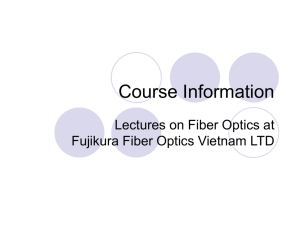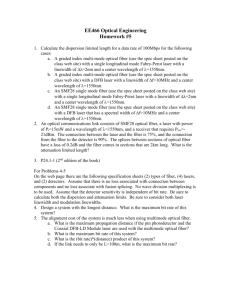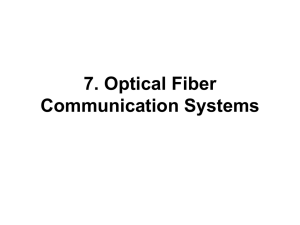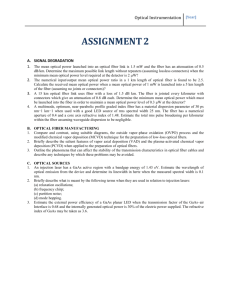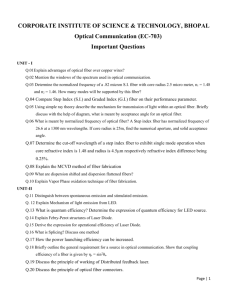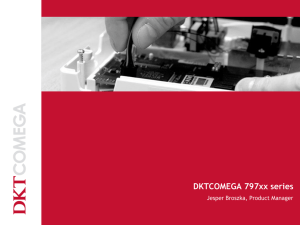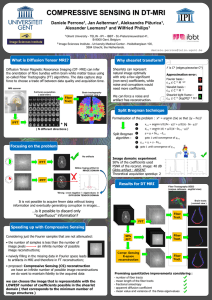Radio over fiber
advertisement
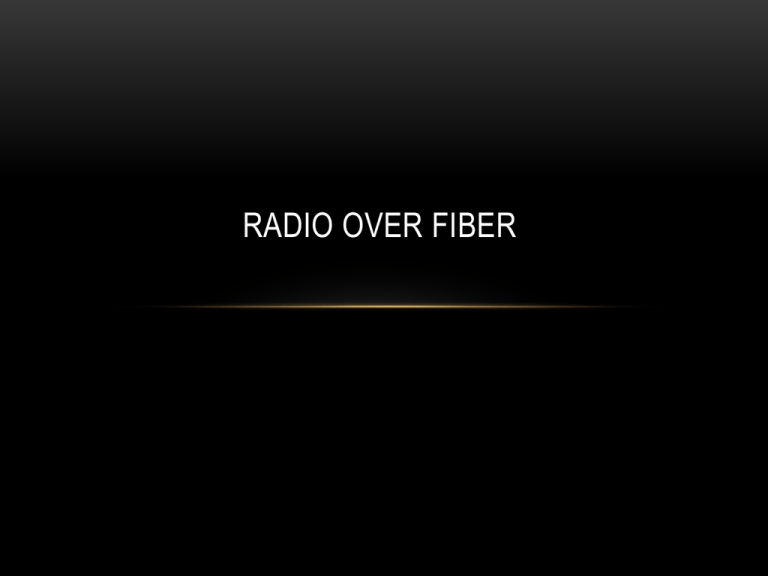
RADIO OVER FIBER AIM OF PROJECT The discussion of the concepts of radio over fiber technology and its techniques for transporting radio signals over optical fiber 1. RADIO WAVE Radio waves propagate (travel) much like surface water waves. They travel near the Earth’s surface and also radiate skyward at various angles to the Earth’s surface. As the radio waves travel, their energy spreads over an ever components, a crest (top portion) and a trough (bottom portion). These components travel outward from the transmitter, one after the other, at a constant velocity (speed). The distance between successive wave crests is called a wavelength Fig (1) Freq. and wavelength The electromagnetic wave spectrum is shown in Figure 2.the part usable for radio communication ranges from below 10 kHz to over 100 GHz 1. RADIO WAVE Figure 2: The radio frequency spectrum 2. OPTICAL COMMUNICATION A communication system transmits information from one place to another, whether separated by a few kilometers. Information is often carried by an electromagnetic carrier wave whose frequency can vary from a few megahertz to several hundred terahertzes. Optical communication systems use high carrier frequencies (100 THz) in the visible or near-infrared region of the electromagnetic spectrum. They are sometimes called light wave systems to distinguish them from microwave systems. 2.1 FIBER OPTIC COMMUNICATION The motivation for developing optical fiber communication systems started with the invention of the laser in the early 1960s. The operational characteristics of this device encouraged researchers to examine the optical spectrum as an extension of the radio and microwave spectrum to provide transmission links with extremely high capacities . 2.2 ADVANTAGES OF OPTICAL FIBER Fiber optic systems have many attractive features that are superior to electrical systems. These include * improved system performance * greatly increased bandwidth and capacity * immunity to electrical noise * Immune to noise (electromagnetic interference and radio frequency interference *lower signal attenuation (loss) * lower bit error rates * No crosstalk, * signal security * and improved safety and electrical isolation. Other advantages include reduced size and weight, environmental protection and signal economy. 2.3 TOTAL INTERNAL REFLECTION Total internal reflection is an optical phenomenon that occurs when a ray of light angle with strikes a medium boundary at an angle larger than a particular critical respect to the normal to the surface. Fig(3): Total internal reflections(n1>n2) TYPES OF FIBERS According to the number of modes of propagation in optical fiber there are two kinds of modes. Single-mode fiber Multi-mode fiber 3. RADIO OVER FIBER (ROF) CONCEPT RoF based on (Radio over Fiber) that refers to a technology that use light to modulate electrical signal (radio signal) and transmit it over optical fiber link to distribute radio signals from central location to remote stations. 3.1 ROF SYSTEM A RoF system consists of a Central Site (CS) and a Remote Site (RS) connected by an optical fiber link or network The transportation of high-frequency signals is more challenging because it requires high frequency components, and large link bandwidth. This means that high-frequency signals are more susceptible to transmitter, receiver, and transmission link signal impairments. The transmission of the RF signal at its frequency, it is not always necessary to do that. For instance, a Local Oscillator (LO) signal, if available, may be used to down-convert the uplink carrier to an IF in the RAU 3.2 BENEFITS OF ROF TECHNOLOGY SOME OF THE ADVANTAGES AND BENEFITS OF THE ROF TECHNOLOGY COMPARED WITH ELECTRONIC SIGNAL DISTRIBUTION 1) Low Attenuation Loss 2) Large Bandwidth 3) Immunity to Radio Frequency Interference 4) Easy Installation and Maintenance 5) Reduced Power Consumption 6) Multi-Operator and Multi-Service Operation 7) Dynamic Resource Allocation 3.4 APPLICATIONS OF ROF • Cellular Networks • Satellite Communications • Video Distribution Systems • Mobile Broadband Services • WLANs • Vehicle Communication and Control



